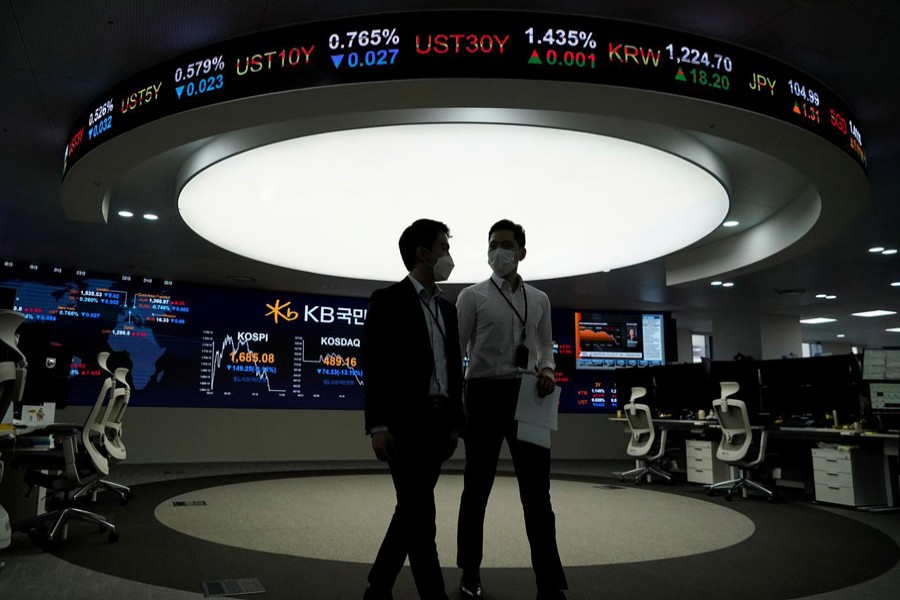Stocks plunged on Friday with coronavirus panic selling hitting nearly every asset class, before finding some kind of floor as hopes turned to a US stimulus package.
European and US stock futures traded in positive territory and some of Asia’s deepest losses were recovered by the end of a session, in which tight liquidity exaggerated moves.
Japan's Nikkei .N225 fell 10 per cent before paring the drop to close 6.0 per cent lower. Australia's S&P/ASX200 had its wildest trading day on record, falling past 8.0 per cent before surging in the last minutes of trade to settle 4.4 per cent higher after the close.
MSCI’s broadest index of Asia-Pacific shares outside Japan .MIAPJ0000PUS wobbled 0.1 per cent higher by late-afternoon after being down more than 5.0 per cent during the morning. It remains set to end the week 11 per cent lower, the biggest drop since 2008.
The turnaround came as central banks from the United States to Australia pumped liquidity into their financial systems and as hopes grew that US Democrats and Republicans could pass a stimulus package on Friday.
It was not clear if the late market moves signalled a recovery in the dire sentiment that has wiped some $14 trillion from world stocks in a month and had Asian markets in freefall at the open.
“It’s like a deja vu of what happened in 2008 but of course the reasons are very different. In 2008, the banks were broken, financial markets were frozen,” said Hou Wey Fook, chief investment officer at DBS Bank. “This time, there are some areas where liquidity has dried up like in bonds but not to the same extent as in 2008.”
While there was no firm explanation from investors on just what prompted the late comeback, some believe the plunge may have run its course for now.
“Lot of clients in the private banking world are sitting on huge amounts of cash. They feel that this is a window of opportunity,” said Hou, adding DBS had been advising clients to invest in tech and healthcare stocks over the past year.
By late afternoon, Hong Kong's Hang Seng .HSI was down 1.9 per cent and Korea's Kospi .KS11 - which had busted through circuitbreakers earlier in the session - had recouped losses to sit 3.4 per cent in the red.
Gold and oil had steadied, but the bond market still bore the scars of the morning’s widespread plunge after the Dow Jones posted its worst drop since the 1987 Black Monday crash.
In the somewhat calmer currency markets, the dollar held its ground as investors nervous about systemic risks drove demand for the world’s reserve currency.
Majors stabilised after furious dollar buying overnight, with the euro EUR= finding footing around $1.1200 and the Aussie AUD=D3 recovering to $0.6300.
Emerging market currencies were punished: the won KRW= and baht THB= dropped as far 1.0 per cent and the rupiah IDR= 2.0 per cent.
Falling knives
The plunge, as the coronavirus pandemic spreads, gathered pace after US president Donald Trump spooked investors with a move to restrict travel from Europe, and after the European Central Bank disappointed markets by holding back on rate cuts.
In a televised address late on Wednesday, Trump imposed restrictions on travel from Europe to the United States, shocking investors and travellers.
Traders were disappointed after hoping to see broader measures to fight the spread of the virus and blunt its expected blow to economic growth.
“Government bureaucracy simply has not kept pace with the nature of the outbreak and market expectations,” said Tai Hui, chief Asia market strategist, J.P. Morgan Asset Management.
“We need to see the number of new infections stabilise...we also need to see fiscal and monetary policy support implementation,” he said.
“Hence, we are not looking at a specific time or valuation to advise investors to add back equities.”
Trade was halted on the S&P 500 .SPX. overnight after it hit circuit breakers. It fell further when trade resumed, eventually losing 9.5 per cent to close 27 per cent below February’s peak.
The VIX volatility index - Wall Street’s “fear gauge” - and an equivalent measure of volatility for the Euro Stoxx 50 .V2TX hit their highest since the 2008 financial crisis.
In commodities, Brent crude LCOc1 rose 1.9 per cent to $33.84 a barrel after falling more than 7.0 per cent on Thursday. US crude CLc1 gained 2.4 per cent to $32.26 per barrel.


